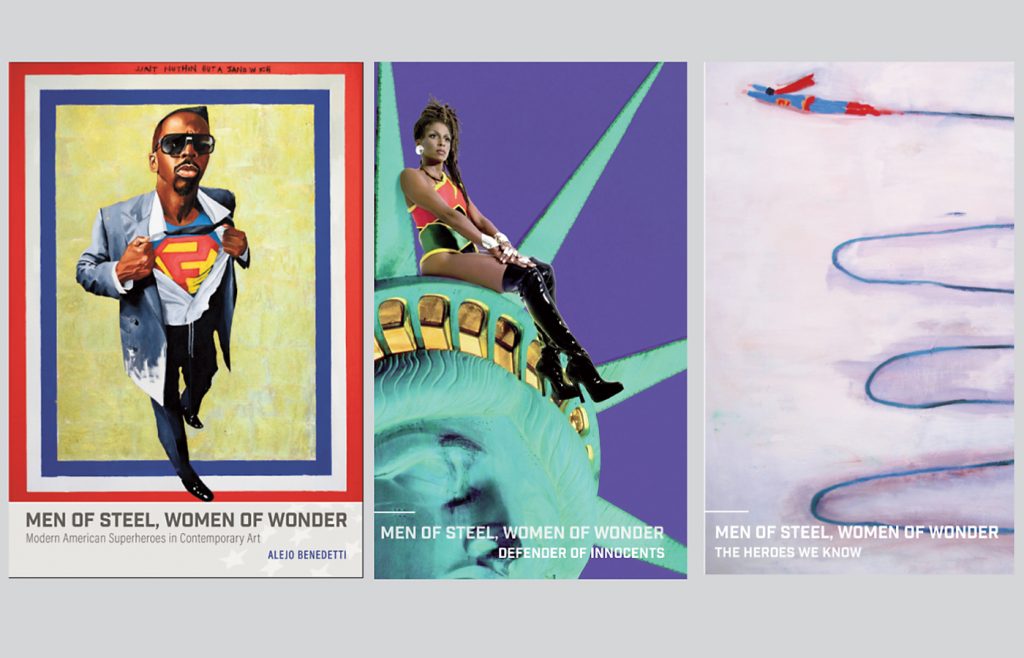
Recently, my wife and I took our middle child to the University of Iowa Art Library, which is located in the Steven Holl-designed Art Building West. Jessica was there to begin her research for the 2019 National History Day competition, during which she is planning to give a presentation about conceptual art. We spent quite some time leafing through books about Marcel Duchamp, his contemporaries, and the artists they inspired. Before too long, however, my eye was drawn to something else entirely.
Men of Steel, Women of Wonder is the name of an art exhibition that originated at Crystal Bridges Museum of American Art in Bentonville, Arkansas, and is currently on exhibit through September 1 at the San Antonio Museum of Art. The beautiful and cleverly structured exhibition catalog for the show was on the shelves of the Art Library, and I not-so-surreptitiously added it to the enormous stack of books Jessica was checking out.
The exhibition, curated by Alejo Benedetti, an assistant curator at Crystal Bridges, focuses on artists’ use of Superman and Wonder Woman for considering a range of notions, from gender roles and immigration (after all, both characters immigrated to the United States) to the underpinnings and limitations of justice and democracy.
The catalog, printed by the University of Arkansas Press, takes the form of a boxed set of comic books of the sort a collector might purchase for display. Each “issue,” numbered 0 to 4, explores a different aspect of the exhibition and features an essay by a scholar. Also included are thoughts from the artists themselves revealing why superheroes have become central to some or all of their work, and striking images of works from the exhibition.
While some of the analysis trods familiar ground (we read more about the Marvel Cinematic Universe than is probably necessary, for example), by and large, the essays are informative and illuminating. Similarly, the artists’ comments provide context that helps the reader understand the ideas behind their artworks.
In his essay “The Spectacular Banality of the Superhero” in the volume entitled “The Heroes We Know,” Bart Beaty, an English professor at the University of Calgary, writes:
Men of Steel, Women of Wonder stitches together contradictory takes on these superheroic figures, seeing them as equal parts spectacular and banal. The works in this show set about the process of elevating the waitress while bringing the crime fighter firmly back down to earth. How do the artists on display here regard supermen and wonder women? One common thread weaves around the legacies of escapism that have characterized American popular culture for well over a century; another takes a microscope to the politics of populism. Superman, in particular, is a product of Depression-era politics where ‘truth, justice, and the American way’ was a phrase that might be uttered unironically. The artists in this show reject such simple populism in asking, Whose truth? What justice? and Which America?
The art that makes up Men of Steel, Women of Wonder is thought provoking, irreverent, and deeply invested in exploring whether superheroes stand in for our best impulses or our worst.
Importantly, many of the artists also wrestle with the whiteness of our most famous fictional heroes. For example, would Americans have so fully embraced Lynda Carter as Wonder Woman in the 1970s if her Mexican heritage were more widely known? The casting of Gal Gadot, Wonder Woman in DC’s cinematic universe and a native of Israel, was certainly met with some racially charged resistance.
It might be tempting to suggest that superheroes lack the gravitas to be the subject of a museum exhibition rather than the newsstand, or that considering serious social issues through the frame of a comic book’s panels minimizes their importance. But Men of Steel, Women of Wonder is an impressive rebuttal of those arguments. Given the prevalence of superhero stories—in America and around the world—the genre deserves, indeed requires, careful consideration, thoughtful analysis, and powerful reimaginings. Men of Steel, Women of Wonder provides all three.
